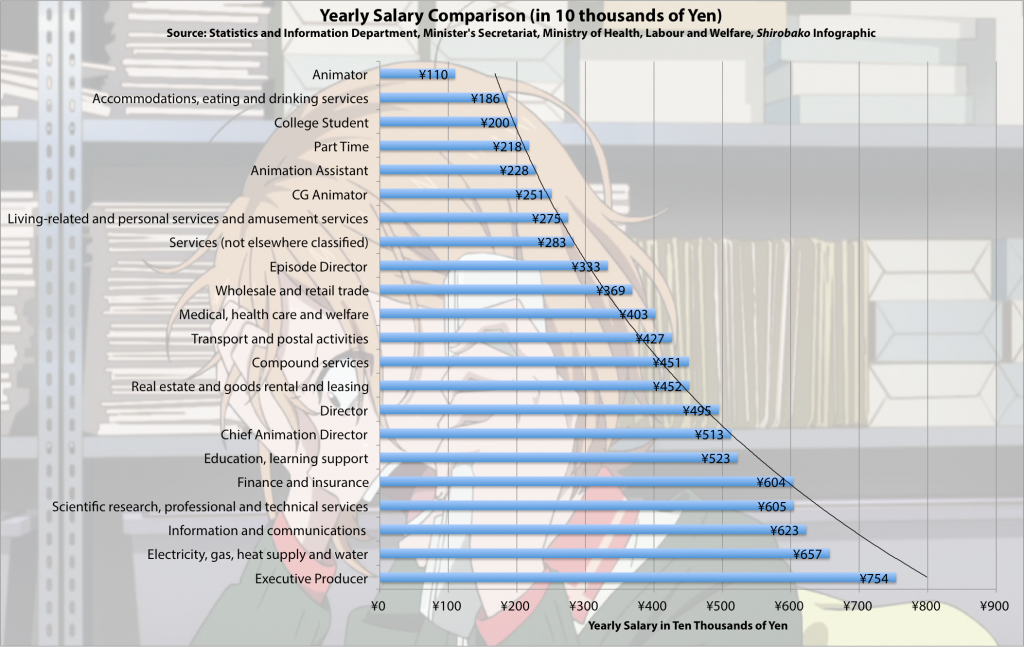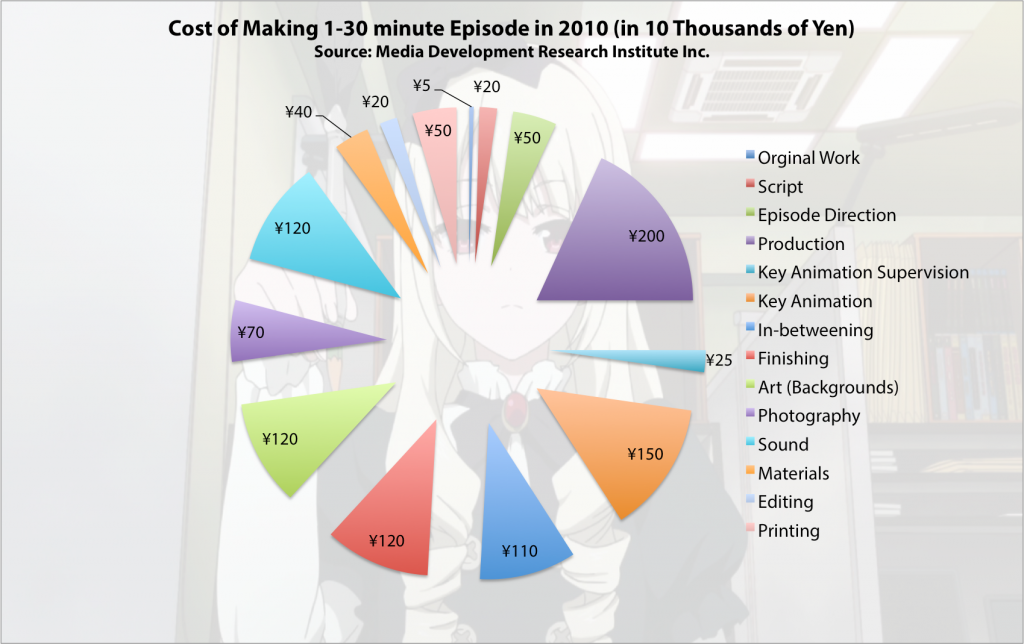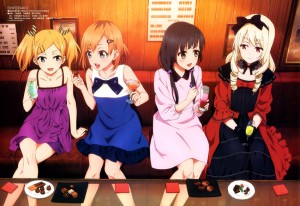Just little over five years ago, I have done some research on how the Anime industry works and of course, I have only covered the surface. Shirobako, which started airing back in October of last year. Not only it reveals how anime is produced, but also blew open some of the internal issues in the industry, especially in regards to the animation studios.
With that, I will be focusing on animator’s wages, working conditions and its implications on the industry as a whole. Also, what steps should the industry take to deal with these issues?
Most people probably came across various articles stating that animators in general are overworked and pay very little. Just several months ago, PA Works gave an estimate of the salaries of occupations dealing with the animation industry. This chart gives a new perspective of how a typical person involved in an anime production earns each year. To take it into perspective, I want to see how they compare to other occupations in Japan. By taking the data from the Statistics Bureau in Japan, which contains monthly data from various industries, I basically totaled up the monthly data from 2013 to get the total salary. With that, I came up with this chart.

While I had to exclude the famous voice actress from the chart since it severely skews the chart, this gives a new perspective of how animation industry’s salaries compares to other industries. As expected, animators in general take home less money (1,100,000 yen a year) compared to people who work in restaurants at 1,860,000 yen a year. Furthermore, only four occupations (episode director, chief animation director, director and executive producer) related to the animation industry excluding voice actors make well above 3 million yen a year.
So, what does this all mean? Compared to other occupations, people who are working in the animation industry, especially animators are either struggling to make end’s meet or barely making it considering the high cost of living in Japan depending on the prefecture. According to the Japan Sociology blog, living in the Osaka prefecture will cost 50,000 yen per month on average for housing. Other expenses include food (about 10,000 yen a week), electricity and gas (5000 yen), and insurance (5000 yen a month). In general, it will cost about 100,000 yen a month in total to live at a bare minimum.
With animator’s monthly salary (91,667 yen per month) being well under the minimum wage compared to an average salary man who works 160 hours a month at minimum wage (106,240 to 142,080 yen a month. Note that minimum wage in Japan ranges from 664 to 888 yen per hour), there is no wonder why many animators in the industry are very dissatisfied with their salaries since they can barely make end’s meet with such low pay. In fact, the amount Ema makes per year is very close to the amount that Asahi Shimbun stated from a survey of 728 animators. It is very saddening for the fact that most animators in general enjoy drawing images, but they get very little to show for their work and most have to work overtime with no pay in most cases.

So, why wages for animators are well below the amount that an average salary man receives at minimum wage? There are many factors ranging from reduced budgets due to falling viewership to poor DVD/Blu-ray sales. From an investigation made by the Media Development Research Institute, a 30-minute episode costs about 11,000,000 yen (you can see the breakdown in this article or the chart above.) In other words, a 1-cour TV show will cost around 132,000,000 yen to produce or 1,122,401.26 US dollars (1 dollar = 117.60 as of February 2, 2015). This may seem to be a lot of money, but in reality, it is not since the middleman in most cases takes a good percentage of the profits. In addition, an in-between animator makes about 220 yen per frame. Given that an average episode has 5000 frames, he/she can expect to make 110,000 yen if one can draw 500 frames. For a beginner or people with less experience, expect that amount to be even less.
Given that most studios can only pay animators very little for their work, what implications does it have on the production quality and the industry as a whole? As stated in my previous editorial on animation mistakes, animators tend to take short cuts in order to meet the deadline. I think that worker morale is also a factor because people might put in less effort due to poor treatment and working conditions.
On the other hand, low wages can also impact the worker’s physical and mental health that it can push them to suicide. There is one notable instance of this with a 28-year-old man animator who worked for A-1 Pictures committed suicide or practically karoujisatsu (過労自殺, suicide caused by overwork) after working 600 hours a month, probably with no overtime pay.
While the Japanese government blamed A-1 Pictures for causing the overwork leading to a man’s suicide, there is no doubt that there are poor working conditions at some of these animation studios. I feel that these issues will ultimately deter young people from joining the profession as they would be more inclined to get jobs that provide better pay and working environment. In the end, I think this can be potentially disastrous for the animation industry as a whole since they will have fewer talented people to replace the veterans that are retiring.
Given the poor working conditions and salary at most animation studios, what should the industry do to fix this problem? The answer is pretty tough since Japan has been facing low birth rate while the audience has been dropping for a while now. This is another reason budgets are getting cut. Top that off with outsourcing along with a management culture that encourages overwork with no pay, it makes the problem even worse. However, I do think that many things needs to be changed as the animator’s salary being well below minimum wage is already considered immoral for a first world country. To me, I think these animators need to unionize and fight for a better wage and better working conditions or the government needs to intervene and force the industry as a whole to treat their workers better. If animators and people in the animation industry are paid better, not only it will help the Japanese economy, but it will also improve the production’s quality. Otherwise, the industry will eventually collapse on itself like a house of cards since fewer people would become interested in working for the animation industry due to the poor treatment of workers and will seek jobs with better pay and benefits.
Hopefully all of this information will give everyone a new appreciation for Japanese animation given the difficulties that most animators face. So, what do you think? Do you think that there are there any solutions to improve the salary and the working conditions at these animation studios? Or do you think that the industry as a whole needs to change so that workers are treated better?
Addendum: (March 11, 2015) Just recently on AnimeSuki, someone shared an interesting article that was published on Buzzfeed that an American animator shared his experiences of becoming an animator in Japan and of course, the experiences he shared is similar to what I already covered. I suggest giving it a read if you haven’t already.



I love this show. Started marathoning this week as I decided to focus on Nanoha mainly during weekends to avoid fatigue.
I was excited for Shirobako, besides it promising a female group as the protagonists (though they kinda are despite Oi being the clear cut main character of the whole thing). I did not expect the show to go as deep as it has but it’s a two cour show so I should not be surprised. The stuff it has been teaching viewers about the anime industry, the factual and dramatized, have all been excellent.
So far the episode that cracked me up most was the seiyuu audition board meeting. I can easily imagine those meetings being as long and insane as that one. I mean look at how hilarious political/governmental meetings are.
As for the whole “the anime industry can be a cruel mistress” message, oh yeah, reading it loud and clear.
I have to admit that Shirobako is probably one of the best shows PA Works made so far. While I agree that it’s dramatized, I agree that it reveals some things about the industry we didn’t know about. Still, there have been interesting articles coming out about the industry showing how tough it is currently. There is one I linked just recently showing how bad the conditions are. Hopefully once people realize this, somehow the industry will change its ways and pay the animators better wages and give them better working conditions.
Of course for Shizuka, it doesn’t get any better. I glanced over a recent article made on AnimeNewsNetwork and only 1 in 100 voice actors become pros… Ouch.